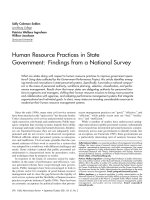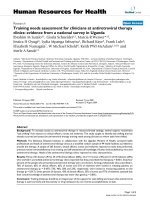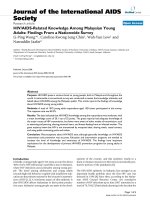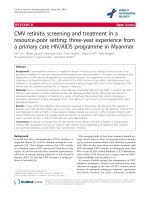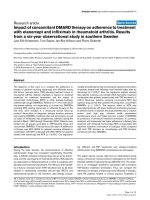Human resource practices in state government findings from a national survey
Bạn đang xem bản rút gọn của tài liệu. Xem và tải ngay bản đầy đủ của tài liệu tại đây (170.42 KB, 10 trang )
598 Public Administration Review • September/October 2001, Vol. 61, No. 5
Sally Coleman Selden
Lynchburg College
Patricia Wallace Ingraham
Willow Jacobson
Syracuse University
Human Resource Practices in State
Government: Findings from a National Survey
What are states doing with respect to human resource practices to improve government opera-
tions? Using data collected by the Government Performance Project, this article identifies emerg-
ing trends and innovations in state personnel systems. Specifically, it provides a national compari-
son in the areas of personnel authority, workforce planning, selection, classification, and perfor-
mance management. Results show that many states are delegating authority for personnel func-
tions to agencies and managers, shifting their human resource missions to being more proactive
and collaborative with agencies, and adopting performance management systems that integrate
organizational and individual goals. In short, many states are investing considerable resources to
modernize their human resource management systems.
Since the early 1990s, many state civil service systems
have been attacked as the “quiet crisis” has become louder.
Critics characterize civil service and personnel systems as
rigid, regressive, rule bound, and cumbersome. Public man-
agers complain that existing systems impede their ability
to manage and make critical personnel decisions. Employ-
ees are frustrated because they are not adequately com-
pensated and do not receive well-deserved recognition.
Political officials depict personnel systems as unrespon-
sive and inefficient. Civil servants grumble that the con-
tinued criticism of their work is caused by a system that
was adopted for a workforce with different challenges and
needs. Some scholars contend that public personnel ad-
ministration is characterized more by procedures, rules,
and techniques than by purpose or results.
In response to the litany of concerns raised by stake-
holders in the name of performance and efficiency, vari-
ous personnel reforms have swept through state govern-
ments. Public managers have been encouraged to look to
the private sector for examples of good human resource
management and to close the gap between the rigidity of
civil service systems and the flexibility of human resource
practices in private industry (Cipolla 1996). There has been
an axiomatic acceptance by political leaders that private-
sector management practices are “good,” “effective,” and
“efficient,” while public sector ones are “bad,” “ineffec-
tive,” and “inefficient.”
While a number of studies have underscored cutting-
edge innovations in public personnel systems, substantially
less research has inventoried personnel practices compre-
hensively across state governments to identify trends (for
an exception, see Carnevale 1995). State governments are
a particularly interesting unit of analysis because they
Sally Coleman Selden is an associate professor of management at Lynchburg
College. Her major areas of research interest include human resource man-
agement, representative bureaucracy, and public management. Her recent
work has appeared in
Public Administration Review, Journal of Public Ad-
ministration Research and Theory, Administration and Society, American
Journal of Political Science,
and
Review of Public Personnel Administration
.
Email:
Patricia Wallace Ingraham is Distinguished Professor of public administra-
tion and political science at the Maxwell School of Citizenship and Public
Affairs. She is the author or editor of a number of books and articles related
to public management and reform. She received the Herbert Simon Award
for Career Contribution to Public Administration and the Career Award from
the American Society for Public Administration for contributions to the study
of human resource management. Email:
Willow Jacobson is a doctoral candidate in public administration at the
Maxwell School of Citizenship and Public Affairs at Syracuse University. She
is a research associate at the Alan K. Campbell Public Affairs Institute. Her
research interests are in the areas of human resource management, public
management, and public service motivation. Email: wsjacobs@
maxwell.syr.edu.
Human Resource Practices in State Government 599
employ approximately 4.7 million individuals, almost 2
million more people than the federal government (U.S.
Bureau of the Census 1999a, 1999b). Moreover, as Hays
and Kearney (1992, 381) observe, “states have … acquired
a well-deserved reputation as incubators (or laboratories)
of innovation that are ultimately transported to the federal
government.” In 1978, Alan K. Campbell, while serving
as chairperson of the U.S. Civil Service Commission, rec-
ognized the importance of state innovations: “I have fol-
lowed with considerable interest the progress in some …
States and must conclude that while Federal policy is of
tremendous importance, the States (California, Oregon,
Wisconsin, Florida, to name but a few) are in many cases
charting the direction in which I believe the Federal Gov-
ernment must move” (Campbell 1978, in Dresang 1982).
Currently, states are adopting human resource management
practices that are forging new directions for the field and
the practice of public personnel.
This article focuses on key personnel functions—par-
ticularly areas that have been highlighted by recent reports
(for example, Little Hoover Commission and Winter Com-
mission)—including general responsibility for personnel
functions, workforce planning, selection, classification,
performance evaluation, and reward systems. The article
seeks to identify trends and emerging practices in state
government. The data reported in this article were collected
by the Government Performance Project (GPP) in 1998.
Civil Service in State Government
The origin of state merit systems are inextricably linked
to the depoliticization of the civil service. The first state
civil service law was enacted in New York in 1883—the
same year Congress passed the Pendleton Act. More than
115 years ago, the Pendleton Act provided a blueprint for
a modern, unified, and politically impartial civil service.
The hallmarks of a merit system included tenure, the use
of written, competitive examinations, and neutral admin-
istration (Sylvia 1989). In the 20 years following the
Pendleton Act and New York’s first civil service law, no
other state established a merit system (Aronson 1974). In
the 1920s and 1930s, technical developments, including
testing and classification, in the field of personnel laid the
groundwork for a more scientific approach to human re-
source management. Despite the advances, many states did
not adopt civil service legislation until the passage of the
Social Security Act in 1935, which included a provision
for grants to states. The act stipulated that states must be
“federally approved”—that is, the state had to provide for
proper and efficient administration—to receive funding.
Leonard White proclaimed in a 1945 article in Public Per-
sonnel Review, “the importance of this amendment to the
steady improvement of personnel standards in the State
and county government cannot be exaggerated” (Aronson
1974, 136). The legacy of the type of civil service system
established by the Pendleton Act is evident. Today, many
states have a civil-service system characterized by an elabo-
rate web of laws, rules, regulations, and techniques em-
bracing the merit principle.
While many federal agencies have experimented with
new human resource practices, many states have been just
as, if not more, aggressive in their endeavor to infuse new
life into their personnel systems. A number of factors have
converged to quicken state-level changes,
1
including, but
not limited to, the following:
• State blue ribbon commissions
• Winter commission report
2
• National Performance Review
3
• Public opinion
• Benchmarking movement
• Performance measurement and results-oriented
management
Many political and government leaders are listening to
findings from blue ribbon commissions, as well as their
constituents’ calls for change, and are pushing civil ser-
vice reform to the top of their agenda. What has been the
outcome of the increased interest in civil service reform?
Some states, such as Maryland and Georgia, have passed
legislation that significantly alters public-employment prac-
tices, while others are currently considering legislative,
regulatory, and programmatic changes, such as Oklahoma
and Washington. In New Jersey, Governor Whitman out-
lined a major civil service reform initiative in her 1998
“State of the State” address that would represent the most
significant overhaul of the state’s human resource man-
agement system since its inception 90 years ago. In the
neighboring state of New York, Governor George E. Pataki
launched a sweeping reform plan to revolutionize the state’s
civil service system. Current civil service reforms and in-
novations are taking place during a period of general com-
motion about the role and shape of government organiza-
tions. Some states have attempted to completely overhaul
their civil service system, while others have tinkered with
particular human resource practices.
There is no single approach to contemporary merit sys-
tem reform. Most proposals for reforming state civil ser-
vice systems fit into three broad categories: (1) those that
promise to reduce the size and scope of the civil service by
making it easier to dismiss employees and by removing
automatic entitlement aspects of civil service; (2) those
that propose to create flexibilities within the existing civil
service system to improve a manager’s ability to manage—
typically include delegating authority for selected person-
nel functions to agencies and managers, reducing person-
nel regulations, and creating incentives for high
performance—without abandoning core merit principles;
600 Public Administration Review • September/October 2001, Vol. 61, No. 5
and (3) those that abolish civil service. Regardless of the
approach taken, states hope to improve how government
works by modernizing personnel practices and adopting
innovative techniques.
4
Data and Methods
This article does not attempt to examine the compre-
hensiveness of reform in individual states; rather, it ad-
dresses trends and innovations in public personnel systems.
The analysis is based upon information collected by the
GPP in 1998. The Alan K. Campbell Institute of the Max-
well School of Citizenship and Public Affairs at Syracuse
University was awarded a four-year grant from The Pew
Charitable Trusts to rate management performance of state
and local governments and selected federal agencies. The
GPP partners a group of academics with journalists from
Governing magazine to evaluate state government man-
agement performance. The GPP’s objective is to evaluate
management performance across five areas: financial man-
agement, capital management, information technology,
human resource management, and managing for results.
In January 1998, surveys were mailed to state budget di-
rectors. Budget directors coordinated the completion of the
human resources section with state personnel directors.
Completed surveys and supporting documentation were re-
ceived from 49 states.
5
The gathered information includes
quantitative data such as the extent of use of performance
tools, as well as qualitative information describing poli-
cies, priorities, and procedures.
This article does not seek to evaluate the performance
of state personnel systems; rather, it reports what states
are currently doing in the following areas: locus of per-
sonnel authority, workforce planning, classification, selec-
tion, and performance management.
Findings
Locus of Personnel Authority
A continuing recommendation on the part of state com-
missions studying civil service is to delegate
personnel authority to line agencies and relax
the onerous controls imposed by a traditional
civil service system (for example, see Little
Hoover Commission 1999, 1995). The implicit
assumption of this recommendation in delegat-
ing authority to state agencies leads to greater
vertical decentralization and ultimately, more
managerial control over personnel practices.
However, the push to decentralize personnel
functions is not a new phenomenon (Heclo
1977, 45). It represents yet another shift in the
cycle of centralization and decentralization of
personnel responsibilities (Ingraham and Rosenbloom
1992). Texas, for example, has operated under a completely
decentralized personnel system where each agency devel-
ops its own personnel policies and procedures.
6
A report
issued by the Texas Office of the State Auditor in 1997
noted some of the potential problems associated with ex-
treme decentralization of personnel responsibility. The key
findings of the report indicate that the State of Texas lacks
information needed to evaluate the costs and results of
human resource management practices; agencies do not
plan adequately for human resource management; and
agencies do not have written policies and procedures to
help ensure that state money is spent effectively.
Decentralized personnel systems typically are more flex-
ible than centralized systems because agencies can cus-
tomize human resource practices to meet their needs, place
authority with decision makers who are closer to the point
of delivery, and give agencies more direct control over the
delivery of human resource services. Centralized person-
nel functions, on the other hand, also offer some benefits;
they have more potential for consistency in the delivery of
human resource services, offer efficiency gains through
economies of scale, and are more explicit about the roles
of agencies and the central personnel office.
The GPP asked states to describe the extent to which
classification, recruiting, testing, hiring, and performance
appraisal procedures were centralized (under the control
of the central personnel agency) or decentralized (man-
aged by individual agencies). Responses varied from com-
pletely centralized to completely decentralized across the
key personnel functions. For example, Nevada delegates
few personnel responsibilities to state agencies. On the
other hand, most personnel actions are decentralized in
South Carolina. As shown in table 1, more than 50 percent
of the states indicated that position classification is main-
tained and administered centrally. Compared to position
classification, states have been more willing to decentral-
ize authority for developing performance appraisal instru-
ments. However, 25 states maintain central authority for
Personnel function
Table 1 Responsibility for Selected Personnel Functions
Classification Recruiting Testing Hiring Performance
appraisals
Number of states
Human Resource Practices in State Government 601
developing performance appraisal instruments. When ex-
amining patterns across regions, our findings indicate that
southern states are significantly more likely to decentral-
ize classification, recruiting, testing, and performance ap-
praisal responsibilities than other states.
Considerable authority is delegated to agencies in the
selection process—including recruiting, testing, and hiring
(see table 1). Agencies in almost all states have complete
authority to select a candidate for an open position, although
some agencies are limited to employment lists of screened
applicants developed by the central personnel office. In many
states, agencies have also been granted latitude in the re-
cruiting process. Several states indicated that recruiting is
decentralized within statewide parameters. For example, in
North Carolina, agencies are subject to a 1997 law (Senate
Bill 886) that requires agencies to have similar recruitment
and selection processes, as well as fair and valid selection
procedures that encourage a diverse workforce. While 26
states responded that testing is conducted by a central au-
thority, several states noted that civil service exams had been
discontinued and agencies had been granted authority to
develop and administer their own selection devices.
When decentralization occurs, questions can arise
about whether personnel policies are being implemented
according to provisions, whether there is equity across
agencies, and whether merit principles are being adhered
to by agencies (Carnevale and Housel 1995; Walters
1997). When authority for personnel actions is decen-
tralized, how do states hold agencies and managers ac-
countable for their actions? Two alternatives were dis-
cussed by states: contracts and evaluation/audit. Utah
delegates personnel functions through a signed contract
between the Department of Human Resource Manage-
ment (DHRM) and the individual agency. The agreement
stipulates that the personnel function must be “conducted
in accordance with applicable state code, DHRM rules,
standards, policies, and procedures.” Although responsi-
bility is delegated, the DHRM provides support to the
contract agencies through training, manuals, and techni-
cal assistance. North Carolina’s central personnel office
put together a division solely dedicated to program evalu-
ation. The state sends a team into an agency to examine
the entire human resources program, including compli-
ance with statutes and federal civil rights laws.
Role and Mission of Central Personnel
Departments
Our findings suggest that as personnel functions are
becoming increasingly decentralized, personnel depart-
ments are assuming a consultative role to support and pro-
vide advice to their clients—state agencies and managers.
In its survey response, Indiana commented, “[a]s agencies
fulfill more of these functions, they need more guidance
and assistance in how to do it. Many of our agencies—we
have 100 or more agencies—are so small that they don’t
have a human resource professional doing their personnel
work. It may be a secretary to the director, or it may be the
director so these people are not technical experts and they
need a lot of hands on guidance—more so now that they
are doing it themselves rather than us doing it.” This state-
ment illustrates an important ramification of decentraliza-
tion. Agencies and their managers are expected to carry
out functions for which they do not necessarily have the
skills, experience, or training to perform. Several person-
nel offices acknowledged that it took time for them to ad-
just to a different role under the new structural arrange-
ment. For example, Ohio indicated that even after
decentralizing, “we would audit an agency, making sure
that every ‘i’ was dotted and ‘t’ crossed, and produce a 60-
page report.” In effect, the personnel office was taking back
all the responsibility that it had delegated. As a result, the
personnel office revamped its regulatory audit process that
emphasized a “just say no” attitude to a more analytic pro-
cess aimed at improving agency practices. Often a shift in
personnel responsibilities is preceded or accompanied by
a change in the mission of the personnel department.
States were asked to provide the stated mission of its hu-
man resource or personnel department. A review of the 49
mission statements reveals that, among the majority of hu-
man resource departments, a preoccupation with policing
the merit system has given way to a broader human resources
focus. However, some states appear to continue to adhere to
a more traditional model of personnel management. For
example, “the mission of Illinois’ human resources bureau
is stated very simply in the enabling legislation, ‘Personnel
Code.’ It states that the purpose is to establish for the gov-
ernment of the State of Illinois, a system of personnel ad-
ministration under the governor based on merit principles
and scientific methods.” A number of state personnel de-
partments have altered their mission to be more consistent
with the language of reinvention. Terms such as flexibility,
streamlining, business, cost-effective, partnerships, and cus-
tomers are used in many of the mission statements. States
vary, however, in the extent to which the terms are employed.
The following mission illustrates the changing rhetoric:
Connecticut’s Human Resources Business Center’s
vision is to establish highly effective human re-
sources systems through partnerships with our cus-
tomers, clients and colleagues, to lead and motivate
by example, to supply expert consultation, and to
deliver timely, quality, and cost effective services and
products. The department is moving
From: To:
Bureaucracy Business
Control Service
602 Public Administration Review • September/October 2001, Vol. 61, No. 5
Hierarchy Front-line workers
Processes/procedures Lower costs and
quality products
Telling customers what Helping customers
to do get things done
Deliberating Delivering
The analysis of state mission statements suggests that a
paradigm shift may be occurring. States appear to be re-
placing the bureaucratic paradigm that once dominated the
culture of state personnel departments (consisting of bu-
reaucracy, control, and hierarchy) with a new paradigm
that emphasizes service, front-line workers, efficiency, and
results. While the analysis is limited to stated missions, as
opposed to observing a department’s operationalization of
that mission, it nonetheless suggests a fundamental shift.
Workforce Planning
Planning, including workforce issues, is often touted
as an integral component of reform (Cipolla 1996).
Workforce planning, defined as a strategy and set of pro-
cedures by which the state’s future personnel needs are
assessed, enables agencies to ascertain their need for and
availability of human resources to meet their objectives.
Cayer (1996) argues that without such knowledge, agen-
cies and their managers will have difficulty maintaining
a highly productive workforce. Ospina (1992) contends
that public agencies are not the best planners; rather, they
tend to be more reactionary. The data appear to support
her observation.
States were asked to describe their workforce plan. As
illustrated in table 2, the majority of states do little to no
formal workforce planning. One state personnel office re-
sponded: “I don’t think anyone does any kind of workforce
planning—either us or the agencies. I don’t think anyone
disagrees with the notion. The idea is that you have lim-
ited resources available to you, both in the agency and in
human resources, and there are so many continuing issues
that you have to deal with that you have to make some
determination of where you put your efforts. At the mo-
ment, the effort isn’t going into workforce planning.” In
fact, only five states have implemented a comprehensive
plan. Workforce planning has been ingrained in the Illi-
nois state government culture since the mid-1950s when
the personnel code was amended requiring the personnel
bureau to “conduct research and planning regarding the
total manpower needs of all offices.” Both Illinois and New
Jersey have established systems that share responsibility
between the central personnel office and agencies. For ex-
ample, New Jersey’s process is described below:
The planning process that we have designed applies
to all executive agencies. Each agency prepares an
Agency Workforce Plan that includes both a Human
Resources Management Plan and an Affirmative
Action Plan. The Department of Personnel supports
the development of these plans by providing each
agency with an attrition forecast by job family, an
analysis of ethnic/gender underrepresentation by
EEO category and occupational group, and other
pertinent information. After each agency prepares
its plan, the Department of Personnel creates a State
Government Workforce Plan by combining the ini-
tiatives planned by the state agencies with initiatives
and programs planned by the Department of Per-
sonnel. The objective of the State Government
Workforce Plan is to provide a workforce with the
specialties and skills needed to execute the strategic
and operational plans of the agencies, as well as the
Governor’s plan for the State Government as a whole.
Only a few states (such as North Carolina and Washing-
ton) have vertically integrated workforce planning with
state and agency strategic planning. Slightly more states
have horizontally integrated workforce planning with other
human resource functions, such as recruitment, selection,
training, and development. Arguably these states will be
better equipped to confront rapid changes in the labor mar-
ket and state environment. While some states are doing
some workforce planning—typically in the larger state
agencies—others are considering more systematic ap-
proaches to state workforce planning. For example, the
Vermont legislature has set up a blue ribbon commission
to outline a plan for workforce and strategic planning.
Compared to the diffusion of strategic planning in state
agencies (Berry and Wechsler 1995), workforce planning
is lagging behind.
Selection Process
The selection process is one of the most critical human
resource functions because it supplies persons with spe-
cific knowledge skills and abilities needed to perform public
services. Currently, government is competing for skilled
labor in an economy with a low unemployment rate and
changing notions about work and organizational commit-
ment. Until recently, Minnesota, like other states, acknowl-
edged that its hiring system had been untouched since it
was adopted in 1939: “As I tell people it is not that what
Table 2 Workforce Planning
Number of states
None to Some Comprehensive
little workforce workforce workforce
planning planning planning
Human Resource Practices in State Government 603
they did was wrong at the time. It was appropriate at the
time. However, today in a very competitive marketplace,
where you have to compete with places for a limited labor
pool, you must have a recruitment process that is fast and
based on merit.” Like Minnesota, most states recognize
that their selection systems have to change to meet the de-
mands of the changing labor market. Many states have re-
sponded by decentralizing aspects of the hiring process, as
evident from table 1, and adopting innovations to speed up
the process.
One area of the selection process that has been at the
top of many states’ agendas is certification or generation
of hiring lists. Many states have adjusted their laws to
provide more flexibility in the size of managers’ candi-
date pools; some states have increased the number or per-
centage of applicants that can appear on a certified list.
For example, Delaware allows a list of 15 percent or 15
applicants (whichever is greater) whereas previously it
provided for 15 percent or 5 applicants. As illustrated in
table 4, four states still adhere to the traditional “rule of
three;” that is, managers are forced to choose among the
top three scores. Other states, such as Maryland, have
moved to the use of bands of qualified applicants. Essen-
tially, all candidates whose scores fall within a certain
band will be deemed qualified and eligible for the posi-
tion. Alabama groups scores that are not statistically dif-
ferent. Rather than ranking scores from 1 through 100,
four bands may emerge. Twenty-three states either pro-
vide a list of all candidates who meet the minimum quali-
fications to the agency or leave it up to the agency to
screen the pool of applicants (see table 3).
Based on the data collected from the states, it appears
that the selection process is evolving and being infused
with new innovations. Several states, such as Kansas, have
abandoned the use of centralized civil service exams and
moved toward skill-matching programs that seek to fill
positions based on a set of core competencies. Several states
have adopted automated application systems that allow
managers to match applicant skills with skills required by
the position. Using such a system, Missouri has reduced
the average time it takes to produce an eligibility list from
six weeks to two weeks. Arizona’s system scans in resumes
and files them in a central database that is used to match
applicants’ skills with skill-sets required by particular jobs.
Utah’s Human Resource Enterprise System also tracks
applicants and matches applicants’ skills with position
qualifications. Utah’s system is particularly interesting
because applicants only have to apply once. Once in the
system, the applicant will be considered for all openings
for which he or she qualifies. Under the old system, an
applicant had to apply separately for each opening in Utah
state government.
Other innovations in the selection process include the
use of pass/fail examinations, walk-in testing, applying
online, and signing bonuses. The Connecticut legislature
passed an act that required all examinations to become pass/
fail. Ohio and Wisconsin accommodate walk-in testing so
that individuals can file an application and take the appro-
priate test at the same time. In 1998, applicants in the states
of California, Florida, Indiana, Kentucky, Michigan, Mis-
souri, Nebraska, and Wisconsin were able to apply for state
jobs online. For hard to fill positions, Colorado allows
managers to use signing bonuses.
The recent surge of attention toward this personnel func-
tion is indicative of the pressure states perceive to improve
the selection process by granting managers more latitude
and adopting technologies and practices that expedite the
hiring process. Early assessments by some states suggest
that agencies are able to hire more quickly and managers
are more satisfied with the process. However, little is known
about whether the changes have increased the quality of
applicants and new hires.
Classification Systems
In an effort to create simplified and more flexible sys-
tems, a number of states have decentralized job classifica-
tion, experimented with broad banding, and reduced the
number of job classifications. In 1998, the data indicate
that 16 states have delegated some responsibility for clas-
sification actions, with 8 of those states delegating all au-
thority to agencies. In Virginia, for example, most classifi-
cation actions are decentralized to the agencies but the
central office still plays a role. The central personnel of-
fice provides “consulting assistance to agencies on request
and monitors agencies’ actions to ensure that consistent
and appropriate actions have been taken.”
In total, more than 19 states are considering broad band-
ing (NASPE 1996). We found that more states are consid-
ering broad banding than have actually adopted it. Of the
states using broad banding, most started by experimenting
in a few agencies before implementing broad banding state-
wide. Minnesota is currently transitioning from approxi-
Table 3 Use of Hiring Lists in State Governments
Number of states
Rule Rules of Between Meets minimum
of 3 4–10 15 and 50 requirement or
scores up to agency
604 Public Administration Review • September/October 2001, Vol. 61, No. 5
mately 2,300 classes to broader classes. The state noted,
“when you take a system that pigeonholed people into very
specific, very narrowly defined jobs, you get a system that
does not allow efficient redeployment of its workforce. So,
in today’s workforce, it is even more incumbent on an or-
ganization to have a system that allows it to redeploy and
reskill its people.” North Carolina responded that its atten-
tion toward broad banding grew out of a concern about
compensation practices in the state and the inability of
managers to recruit in a timely way and to reward employ-
ees. Recognizing that its 1970s classification system was
outdated, North Carolina concluded that broad banding was
the answer to streamlining the extensive number of classi-
fications that plagued the state. Wyoming, in an early as-
sessment of its broad banding effort, indicated that man-
agers have more flexibility; managers no longer have to
reclassify a position in order to recruit someone with a
different skill set than the previous occupant.
In addition to banding efforts, many states have con-
centrated on reducing the number of job classifications (see
table 4). Between 1991 and 1998, 30 states reduced the
number of job classifications. The number of job classifi-
cations in New York fell from 7,300 to 5,075; in South
Carolina from 2,318 to 500; and in West Virginia from 2,000
to 750. However, classification titles did not decrease in
all states. During the seven-year period, growth occurred
in 15 states. One state that is particularly interesting is
Georgia. As part of the Georgia Gain program, state agen-
cies reexamined, redefined, and reconfigured their jobs.
Since each agency is responsible for its own classification
process, it has the authority to create or delete jobs as it
sees fit. According to the state, agencies like the flexibility
of the new system and are willing to deal with more titles.
However, the state acknowledged, that if the number of
classifications continues to climb, the system might be
“difficult to manage because theoretically you can have
one job for every position.”
With the exception of Georgia, most states are attempt-
ing to reduce the number of job classifications by combin-
ing, eliminating, or banding classes. While broad banding
is mentioned by many states, only a few states have adopted
a statewide system.
Performance Evaluation and Reward Systems
Performance appraisal systems have often been criti-
cized as being meaningless because most employees re-
ceive an above average rating (Thompson and Radin 1997).
Moreover, many employees express dissatisfaction with
appraisal systems because they believe objective perfor-
mance measures are lacking and supervisors are biased in
their ratings (Pynes 1997). Problems with performance
appraisals are often cited as reasons why merit pay and
pay-for-performance systems fail (Kellough and Selden
1997). Research has shown that when pay is linked to per-
formance appraisals, employees set lower goals and focus
on receiving pay increases rather than improving their per-
formance and their professional development (Pynes 1997).
After an employee’s probationary period, 75.5 percent
of states (37) require an annual formal performance ap-
praisal. Eleven states require supervisors to evaluate their
Table 4 Job Classifications 1991 and 1998
Number of Number of Percentage
classifications classifications Change change
State 1991 1998
Alabama 1,600 1,400 –200 –12.50
Alaska 1,050 1,500 450 42.86
Arizona 1,500 1,400 –100 –6.67
Arkansas 1,900 1,854 –46 –2.42
California 4,324 4,500 176 4.07
Colorado 1,348 951 –397 –29.45
Connecticut 2,600 2,600 0 0.00
Delaware 1,434 1,400 –34 –2.37
Florida 1,596 1,537 –59 –3.70
Georgia 1,570 2,355 785 50.00
Hawaii 1,660 1,600 –60 –3.61
Idaho 1,550 1,400 –150 –9.68
Illinois 1,680 1,011 –669 –39.82
Indiana 1,500 1,300 –200 –13.33
Iowa 1,250 812 –438 –35.04
Kansas 1,142 750 –392 –34.33
Kentucky 1,614 1,750 136 8.43
Louisiana 3,800 2,800 –1,000 –26.32
Maine 1,500 1,100 –400 –26.67
Maryland 3,000 2,000 –1,000 –33.33
Massachusetts 1,150 1,100 –50 –4.35
Michigan 2,700 1,500 –1,200 –4.44
Minnesota 2,140 2,269 129 6.03
Mississippi 2,053 2,400 347 16.90
Missouri 1,100 1,300 200 18.18
Montana 1,350 1,500 150 11.11
Nebraska 1,300 1,500 200 15.38
Nevada 1,300 1,300 0 0.00
New Hampshire 1,490 1,100 –390 –26.17
New Jersey 6,400 8,000 1,600 25.00
New Mexico 1,200 1,200 0 0.00
New York 7,300 5,075 –2,225 –30.48
North Carolina 3,500 3,500 0 0.00
North Dakota 1,075 1,000 –75 –6.98
Ohio 1,804 2,500 696 38.58
Oklahoma 1,418 1,462 44 3.10
Oregon 1,100 780 –320 –29.09
Pennsylvania 2,782 3,000 218 7.84
Rhode Island 1,500 1,400 –100 –6.67
South Carolina 2,318 500 –1,818 –8.43
South Dakota 551 551 0 0.00
Tennessee 2,258 1,800 –458 –20.28
Texas 1,339 790 –549 –41.00
Utah 2,500 2,300 –200 –8.00
Vermont 1,280 1,300 20 1.56
Virginia 1,888 1,800 –88 –4.66
Washington 2,100 1,600 –500 –23.81
West Virginia 2,000 750 –1,250 –62.50
Wisconsin 2,000 2,800 800 40.00
Wyoming 774 550 –224 –28.94
Sources: GPP (1998) and National Association of State Personnel Executives and the
Council of State Government (1992) in National Commission on the State and Local
Public Service (1993). Some of the numbers represent estimates.
Human Resource Practices in State Government 605
staff twice a year. Only one state, Rhode Island, does not
require a formal review of its permanent employees. In
North Carolina, Kansas, and Utah, some agencies man-
date quarterly performance appraisals of their employ-
ees. New Jersey’s new performance appraisal system re-
quires at least three interactive discussions between
employees and their supervisors. The first session is the
initial performance agreement which signals that the
employee and supervisor have discussed the unit’s work
goals, the employee’s goals and specific work responsi-
bilities, the expected standards of achievement, and the
performance rating scales and methodology. Six months
into the cycle, the supervisor and employee meet to dis-
cuss progress to date. Together, a development plan is
also devised. The third formal meeting occurs at the end
of the performance cycle.
Recent innovations include developing performance
management systems that support a performance-driven
culture. A performance management system requires that
employees and managers jointly prioritize and determine
goals and objectives, establishes how employees or teams
contribute to the organization’s goals, identifies strengths
and weaknesses of an individual’s performance, and rec-
ognizes and rewards high performance. The first step is
for top-level executives to articulate an agency’s mission
and goals. Then, managers and program directors work
from this directive to determine strategic and measurable
objectives for their unit. From these objectives, managers
and employees collaborate to establish team and individual
performance objectives.
This approach assumes that by aligning individual and
team objectives with agency goals, employees at all lev-
els will have greater ownership of the agency’s goals. The
agency benefits because employees should be more re-
sults-driven. Employees benefit because they feel a greater
sense of accomplishment by achieving meaningful ob-
jectives and by having the potential to be rewarded based
on their performance. Several states, such as Maryland,
New Jersey, Colorado, Georgia, Louisiana, and Delaware,
have explicitly attempted to link employee performance
to agency goals.
Colorado’s Peak Performance system revamps the state’s
performance appraisal system and links it to a compensa-
tion plan. The performance-evaluation component links
individual objectives to state business objectives and strat-
egies, and the compensation plan directly ties pay to an
employee’s performance. Agencies are required to develop
a plan for adopting performance management rules and
procedures tailored to their unique business needs, while
supporting the overall goals and strategies of the state’s
leaders. The performance management system requires
supervisors to create a written performance plan for each
employee at the beginning of a rating period, prepare a
written evaluation, and then review that evaluation. The
evaluation systems that are adopted must translate into three
ratings; needs improvement, fully competent, and peak
performer. Within those parameters, agencies are free to
develop any system that works for them. Monetary awards
will be based on two items: whether the employee is at or
above the job rate for the occupational group and the
employee’s performance level. Employees below the job
rate are eligible for base or non-base building awards.
Employees at or above job rate are eligible for non-base
building awards that must be reearned annually.
Many of the new approaches to performance evalua-
tion require that employees and managers collaborate on
setting performance expectations that are directly linked
to agency goals. Managers are encouraged to track per-
formance and provide regular feedback, and some states
even require more than one formal evaluation each year.
Some systems are designed to allow other stakeholders,
such as customers and subordinates, to rate employee per-
formance. The key to the success of performance man-
agement is providing employees with opportunities to
develop, through training or mentoring, in areas where
they show weakness. Finally, employees should be re-
warded financially for their contribution to the agency’s
success. States vary in terms of the formula used for re-
warding high performance. For example, in Georgia, per-
formance increases are comprised of two components.
Employees who meet, exceed, or far exceed their perfor-
mance expectations receive a market adjustment—to in-
crease competitiveness with the outside job market—and
a variable award, based on the level of performance.
States were asked how long and to what extent they
used the following performance tools: individual perfor-
mance bonuses, group performance bonuses, job flexibil-
ity, and time flexibility. As shown in table 5, states used
the two monetary tools less frequently than the nonmon-
etary tools. Only 14.3 percent of states used individual
performance bonuses, and 2 percent of states often
awarded group bonuses. Time flexibility appears to be
the most popular tool, with 38.8 percent of the states in-
dicating they often employed this method. As an added
incentive, several states, such as Washington, are tying
pay increases to development activities, such as training,
skills acquisition, and education.
Table 5 Use of Performance Tools by States
Percentage of states (n=49)
Never Rarely Sometimes Often
Monetary
Individual performance 40.8 22.4 22.4 14.3
Group performance 65.2 20.4 12.2 2.0
Non-monetary
Job flexibility 34.7 14.3 36.7 14.3
Time flexibility 22.4 2.0 36.7 38.8
606 Public Administration Review • September/October 2001, Vol. 61, No. 5
Conclusion
Major findings from this research indicate that penetrat-
ing changes are occurring in state civil service systems. In
particular, the notion of a state civil service with a uniform
system of employment, recruitment, classification, and
compensation is giving way to a more flexible and varied
structure. The emerging strategy to decentralize authority
for personnel functions is increasing the autonomy of state
agencies and managers. The analysis reveals considerable
activity is taking place in several of the personnel areas
examined. We found a number of states are expending en-
ergy revamping their classifications system by streamlin-
ing the process, reducing the number of titles, or adopting
broad banding systems. Similarly, several states are adopt-
ing performance management systems that link agency and
individual goals and subsequently reward high perfor-
mance. Currently, there is relatively little effort being put
into workforce planning, although it does appear to be an
agenda item for some states. Prior to the recent wave of
reforms, civil service structures and procedures were nearly
universal in state government (Tolbert and Zucker 1983).
Whether or not “new” models of civil service will become
similarly institutionalized or widely accepted as both ap-
propriate and necessary remains to be seen.
What do the findings suggest about the direction of state
personnel systems for the twenty-first century? The state
personnel system of the future will need to couple mana-
gerial and system flexibilities with issues of system fit or
congruence. Emerging personnel systems should consider
both vertical and horizontal fit. Vertical fit refers to the
alignment of state human resource management with stra-
tegic planning and management of state government;
whereas horizontal fit focuses on the extent to which the
human resource practices fit together. Vertical fit will en-
able a state to achieve its goals, while horizontal fit will
ensure state resources are allocated efficiently. At the same
time, states will require systems that can be adapted quickly,
give managers authority to act, and protect merit principles.
As personnel functions are decentralized, human re-
source management will become more interwoven into the
fabric of agency operations and thus less isolated from
managers. The role of the central personnel office will likely
continue to evolve as it keeps pace with changes in the
state environment and responds to the needs of its part-
ners, clients, and customers. In the future, central offices
are likely to focus less on micro issues of human resources
and more on macro issues, such as change management,
employee development and training, managerial consulta-
tion, and leadership development. State personnel depart-
ments will play a pivotal role in helping agencies compete
for and develop a highly-skilled labor force and will posi-
tion themselves to be recognized as an asset to managers
and agencies.
Acknowledgments
An earlier version of this paper was presented at the 60th
national conference of the American Society for Public Admin-
istration, April 10–14, 1999, Orlando, Florida. The authors would
like to thank Lou Heinzer for his research assistance.
Notes
1. Many of these factors have also been catalysts for change at
the federal and local level.
2. Like the federal government’s National Performance Review,
the Winter Commission’s report established an agenda for
reforming personnel administration in state government (Na-
tional Commission on the State and Local Public Service
1993; Thompson and Radin 1997). Specifically, the Com-
mission called for a decentralized merit system, use of selec-
tion devices other than written tests, and expansion of “certi-
fied lists” of candidates. In addition, the report suggests that
states should reduce the number of job classifications by us-
ing broad bands. Similarly, it advocates using broad pay bands
to create “a simple pay and promotion structure that would
allow much greater flexibility in rewarding good employees
and also encourage greater movement of employees across
agencies and easier reassignment on an as needed basis” (Na-
tional Commission on the State and Local Public Service
1993, 29). The Winter Commission offered advice on state
compensation strategies. First, states should adopt the pri-
vate sector’s vesting benchmark—five years. Second, states
should rethink individually based pay-for-performance sys-
tems, which are typically marred by a myriad of problems,
and instead, consider a team-based pay-for-performance sys-
tem, such as gain sharing, that encourages employees to con-
tribute to the overall success of the agency. Additional rec-
ommendations include spending 3 percent of personnel
expenditures on employee education and training, enhancing
the authority of the governor, reducing the number of middle
managers, and developing more cooperative relationships
between labor and management.
3. Although NPR specifically addressed conditions in the fed-
eral government, its influence penetrated all levels of gov-
ernment.
4. This article does not attempt to evaluate the comprehensive-
ness or congruence of personnel reform within states. Instead,
the analysis examines what states are doing with respect to
particular personnel functions.
5. California did not respond to the GPP survey.
6. In Texas, classification is the only human resource function
centralized; it falls under the control of the Office of the State
Auditor.
Human Resource Practices in State Government 607
References
Aronson, Albert H. 1974. State and Local Personnel Adminis-
tration. In Classics of Public Personnel Policy, 2nd ed., ed-
ited by Frank J. Thompson, 133–42. Pacific Grove: Brooks/
Cole Publishing.
Berry, Frances, and Barton Wechsler. 1995. State Agencies’ Ex-
perience with Strategic Planning: Findings from a National
Survey. Public Administration Review 55(2): 159–68.
Campbell, Alan K. 1978. Speech to conference on Public Per-
sonnel Management Reform. January 23, 1978, Washington,
DC.
Carnevale, David G. 1995. Merit System Reform in the States:
Partnerships for Change. Norman, OK: University of Okla-
homa.
Carnevale, David G., and Steve Housel. 1995. Recruitment of
Personnel. In Handbook of Public Personnel Administration,
edited Jack Rabin, Thomas Vocino, W. Bartley Hildreth, and
Gerald Miller, 241–65. New York: Marcel Dekker.
Cayer, Joseph N. 1996. Public Personnel Administration In The
United States. 3rd ed. New York: St. Martin’s Press.
Cipolla, Frank P. 1996. Human Resource Management in the
Federal Government: A Retrospective. The Public Manager:
The New Bureaucrat 25(1): 17–9.
Council of State Governments. 1998. The Book of the States
1998–99 Edition. Vol. 32. Lexington, VA: Council of State
Governments.
Dresang, Dennis L. 1982. Diffusion of Civil Service Reform:
The Federal and State Governments. Review of Public Per-
sonnel Administration 2(1): 35–47.
Gore, Al. 1993. From Red Tape to Results: Creating a Govern-
ment that Works Better and Costs Less. Washington, DC: U.S.
Government Printing Office.
Government Performance Project. 1998. Human Resource Man-
agement Survey. Available at />statereport1999.htm.
Hays, Steven W., and Richard C. Kearney. 1992. State Person-
nel Directors and the Dilemmas of Workforce 2000: A Sur-
vey. Public Administration Review 52(3): 380–8.
Heclo, Hugh. 1977. The Idea of Civil Service: A Third Force? In
Classics of Public Personnel Policy, 2nd ed., edited by Frank
J. Thompson, 41–50. Pacific Grove: Brooks/Cole Publish-
ing.
Ingraham, Patricia W., and David H. Rosenbloom. 1992. The
State of Merit in the Federal Government. In Agenda for Ex-
cellence: Public Service in America, edited by Patricia W.
Ingraham and Donald F. Kettl, 274–96. Chatham, NJ:
Chatham House.
Kellough, J. Edward, and Sally Coleman Selden. 1997. Pay-for-
Performance Systems in State Government: Perceptions of
State Agency Personnel Managers. Review of Public Person-
nel Administration 17(1): 5–21.
Little Hoover Commission. 1995. Too Many Agencies, Too Many
Rules: Reforming California’s Civil Service. Sacramento, CA:
State of California.
———. 1999. Of the People, By the People: Principles for Co-
operative Civil Service Reform. Sacramento, CA: State of
California.
National Association of State Personnel Executives (NASPE).
1996. State Personnel Office: Roles and Functions. 3rd ed.
Lexington, KY: NASPE.
National Association of State Personnel Executives and the Coun-
cil of State Government. 1992. State Personnel Office: Roles
and Functions. Lexington, KY: NASPE.
National Commission on the State and Local Public Service.
1993. Hard Truths/ Tough Choices: An Agenda for State and
Local Reform. Albany, NY: Rockefeller Institute of Govern-
ment.
Ospina, Sonia M. 1992. When Managers Don’t Plan: Conse-
quences of Non-Strategic Public Personnel Management.
Review of Public Personnel Administration 12(1): 52–67.
Pataki, George E. 1995. Governor Announces Sweeping Civil
Service Reform. Available at />press/civil.html. Accessed December 14, 1995.
Pynes, Joan E. 1997. Human Resources Management for Public
and Nonprofit Organizations. San Francisco, CA: Jossey-
Bass.
State of Texas, Office of the State Auditor. 1997. An Assessment
of Human Resource Management Control in Texas State
Government. Austin, TX: State of Texas, Auditor’s Office.
Sylvia, Ronald D. 1989. Critical Issues in Public Personnel
Policy. Pacific Grove, CA: Brooks/Cole Publishing.
Thompson, Frank J., and Beryl A. Radin. 1997. Reinventing
Public Personnel Management: The Winter and Gore Initia-
tives. In Public Personnel Management: Current Concerns,
Future Challenges, edited by Carolyn Ban and Norma M.
Riccucci. New York: Longman Publishers.
Tolbert, Pamela, and Lynn G. Zucker. 1983. Institutional Sources
of Change in the Formal Structure of Organizations: The Dif-
fusion of Civil Service Reform, 1880–1935. Administrative
Science Quarterly 28(1): 22–39.
United States Bureau of the Census. 1999a. Federal Government
Civilian Employment by Function: October 1997. Available
at Accessed
March 13, 1999.
———. 1999b. State Government Employment Data: March
1997 United States Totals. Available at />govs/apes/97stus.txt. Accessed March 13, 1999.
Walters, Jonathan. 1997. Who Needs Civil Service. Governing
10(8): 17–21.

